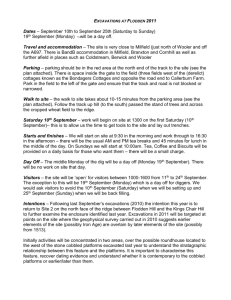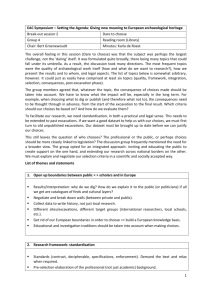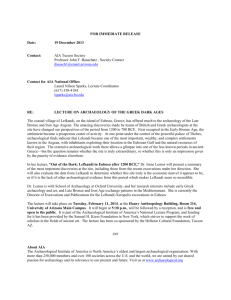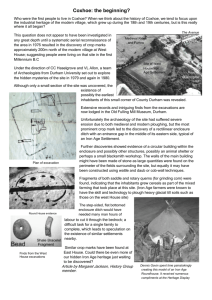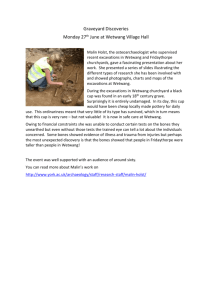The Lands of Ancient Lothian: Interpreting the Archaeology of the A1
advertisement
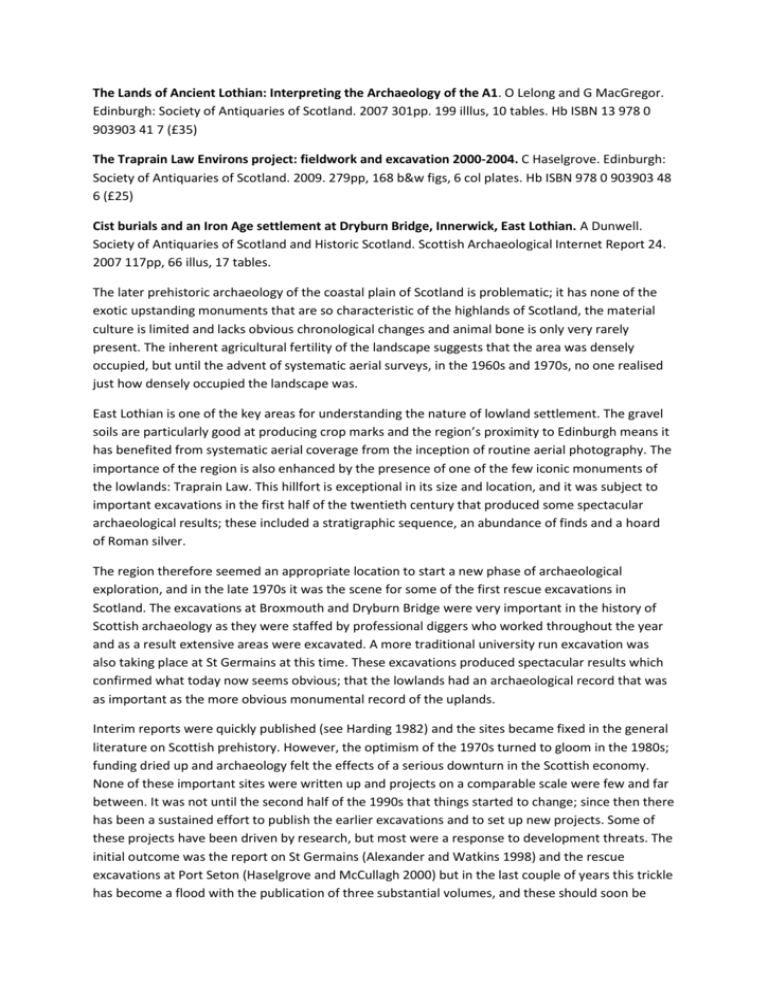
The Lands of Ancient Lothian: Interpreting the Archaeology of the A1. O Lelong and G MacGregor. Edinburgh: Society of Antiquaries of Scotland. 2007 301pp. 199 illlus, 10 tables. Hb ISBN 13 978 0 903903 41 7 (£35) The Traprain Law Environs project: fieldwork and excavation 2000-2004. C Haselgrove. Edinburgh: Society of Antiquaries of Scotland. 2009. 279pp, 168 b&w figs, 6 col plates. Hb ISBN 978 0 903903 48 6 (£25) Cist burials and an Iron Age settlement at Dryburn Bridge, Innerwick, East Lothian. A Dunwell. Society of Antiquaries of Scotland and Historic Scotland. Scottish Archaeological Internet Report 24. 2007 117pp, 66 illus, 17 tables. The later prehistoric archaeology of the coastal plain of Scotland is problematic; it has none of the exotic upstanding monuments that are so characteristic of the highlands of Scotland, the material culture is limited and lacks obvious chronological changes and animal bone is only very rarely present. The inherent agricultural fertility of the landscape suggests that the area was densely occupied, but until the advent of systematic aerial surveys, in the 1960s and 1970s, no one realised just how densely occupied the landscape was. East Lothian is one of the key areas for understanding the nature of lowland settlement. The gravel soils are particularly good at producing crop marks and the region’s proximity to Edinburgh means it has benefited from systematic aerial coverage from the inception of routine aerial photography. The importance of the region is also enhanced by the presence of one of the few iconic monuments of the lowlands: Traprain Law. This hillfort is exceptional in its size and location, and it was subject to important excavations in the first half of the twentieth century that produced some spectacular archaeological results; these included a stratigraphic sequence, an abundance of finds and a hoard of Roman silver. The region therefore seemed an appropriate location to start a new phase of archaeological exploration, and in the late 1970s it was the scene for some of the first rescue excavations in Scotland. The excavations at Broxmouth and Dryburn Bridge were very important in the history of Scottish archaeology as they were staffed by professional diggers who worked throughout the year and as a result extensive areas were excavated. A more traditional university run excavation was also taking place at St Germains at this time. These excavations produced spectacular results which confirmed what today now seems obvious; that the lowlands had an archaeological record that was as important as the more obvious monumental record of the uplands. Interim reports were quickly published (see Harding 1982) and the sites became fixed in the general literature on Scottish prehistory. However, the optimism of the 1970s turned to gloom in the 1980s; funding dried up and archaeology felt the effects of a serious downturn in the Scottish economy. None of these important sites were written up and projects on a comparable scale were few and far between. It was not until the second half of the 1990s that things started to change; since then there has been a sustained effort to publish the earlier excavations and to set up new projects. Some of these projects have been driven by research, but most were a response to development threats. The initial outcome was the report on St Germains (Alexander and Watkins 1998) and the rescue excavations at Port Seton (Haselgrove and McCullagh 2000) but in the last couple of years this trickle has become a flood with the publication of three substantial volumes, and these should soon be followed by the long awaited volume on the Broxmouth excavations, plus a volume on the new work at Traprain Law. They look set to make East Lothian the best documented lowland region in Scotland and northern England for some considerable time to come. The first two volumes, The Lands of East Lothian and The Traprain Law Environs Project, are handsome hardback volumes, whereas the third volume on Dryburn Bridge is available on the internet as a downloadable pdf. The Lands of Ancient Lothian presents the results of the rescue excavations in advance of the upgrading of the A1 from Haddington to Dunbar that took place between 2001 and 2004 and covers eleven sites that span the period from the Mesolithic to the Roman Iron Age. The Traprain Law Environs Project in contrast presents the results of a University research project designed to examine the character of the small settlements that surround the substantial hillfort of Traprain Law. The project took place between 2000 and 2004, three major and three minor excavations were undertaken and 30 sites were surveyed. The final report on Dryburn Bridge concerns the excavation of a single crop mark enclosure between 1978 and 1979 that was threatened by a limestone quarry. The importance of this site rests upon the scale of the excavations, this is the only project which involved the complete excavation of a substantial settlement. A large palisaded enclosure was completely exposed and up to ten houses, associated with the enclosure and a later unenclosed settlement, were completely excavated. Furthermore a cemetery thought to be contemporary with at least one phase of the settlement was discovered. The settlement was much better preserved than the settlements excavated by the other projects, and this has made the interpretation of the houses much clearer. The Traprain Law Environs Project has a fairly conventional layout. After the introduction the three principal sites are described in individual chapters and then the subsidiary excavations are grouped together in a single chapter. The site descriptions include summary mentions of the material recovered but this is more fully described in the following chapters which cover the material remains, the agricultural economy and the chronology. There are then two concluding discussion chapters. The material is presented in admirable detail with considerable clarity and the various specialists involved in the project should be congratulated on their efforts. Many of the sites proved to be poorly preserved and it is clear that substantial ploughing has taken its toll; finds assemblages are relatively impoverished and almost no bone survives. Nevertheless Hunter has provided an exemplary report that places the material recovered into its regional context and demonstrates that there is still important information that can be extracted. The largest assemblage of material recovered by the project is the carbonised plant remains and this was the result of an extensive programme of sampling which was at the heart of the project. This is clearly a valuable resource for understanding the agricultural economy, and Huntley is able to outline several important patterns which indicate chronological change and others that differentiate this area from other areas of Britain. Hopefully these patterns will be confirmed and refined by future work. Cowley provides an excellent discussion of the settlement patterns in East Lothian, but as I will argue below his analysis and the final discussion may be partially flawed by the uncritical acceptance of some of the excavation results. The approach taken in The Lands of Ancient Lothian is quite different. The chapters are organised, not by site but chronologically, with the evidence from the different sites brought together in periods. Thus the site at Eweford West, which has a sequence which includes a Mesolithic lithic scatter, a very important Neolithic mortuary complex, a Bronze Age cemetery and an Iron Age cist is distributed across four of the six descriptive chapters. This makes the reader’s appreciation of the sites very difficult. As the authors rightly emphasise, the repeated reuse of these sites is not accidental but deliberate and relates to quite a specific reading of the monument by later generations. However, this is often difficult to disentangle, particularly as the plans are very simplified and don’t enable an examination of the relationship between contemporary features and the ancient monument. The volume is also very poorly proof read and the various errors included the misspelling of one of the authors names in a title page (page 69). The emphasis throughout the description of the archaeological record is on the site stratigraphy and supports recent criticism that commercial archaeology is uninterested in the material recovered from excavations. None of the specialist reports derived from these excavations have been published; all that is presented are small inserts which provide details of significant themes or objects and abbreviated summaries written by the field archaeologists, which are so bland as to be worthless. This is particularly puzzling as this apparently well funded project had many excellent reports written by specialists who are regarded as leading the field in the analyses undertaken. Access to these reports is through the archive held by the National Monuments Record in Edinburgh, which will be an expensive trip for anyone outside Scotland who might be interested in knowing anything about this material. The archive contents, listed in an appendix, make no reference to site stratigraphic reports, or sample and context lists for the different sites, so it cannot be regarded as a complete archive. Nor is there any suggestion that the specialists were encouraged to write any analysis which compared and contrasted the assemblages from different sites, though I have been informed these do exist. This seems to be a particularly unhelpful approach and cannot be passed off as an attempt to create an integrated report. The Dryburn Bridge volume takes a fairly conventional approach to the structure of its report. It works through the different features of the site characterising them and highlighting chronological information and any evidence for sequence. There is interesting evidence for early prehistoric activity which includes two particularly fine Beaker period cist burials, but most of the archaeological record belongs to the beginning of the first millennium BC with only a few later, Roman Iron Age features. A chapter is devoted to the artefacts, though their discussion is slightly restricted by the subsequent loss of some of the material after the initial reports had been written. A small collection of animal bones exist, but unfortunately the excavations took place before environmental sampling was routine and so no carbonised plant remains were recovered. An important discovery was a cemetery contemporary with the settlement. But again the bone was poorly preserved and only a limited amount of information was available on gender and age. One of the principal goals of all these projects has been to establish a chronological framework for the excavated sites. This is particularly important for the later prehistoric enclosures as the established typological framework, the ‘Hownam Sequence’,i was undermined by an interim report on the settlement sequence at Dryburn Bridge. In the absence of a ceramic sequence and a general shortage of dateable finds, these excavations relied on large numbers of radiocarbon dates to establish chronology. The results from the Traprain Law Environs Project have been particularly interesting in suggesting that several enclosures were created at the end of the second millennium BC, which is much earlier than the previous models suggested. These conclusions have already been quoted by several authors on the basis of preliminary results and they are used in The Lands of Ancient Lothian to support some of the arguments made there. Clearly they are worth exploring in some detail. Ideally to establish a decent radiocarbon chronology the authors should meet the following criteria: a large number of dates; the precise quantity depends on the complexity of the site, but in the case of the later prehistoric sites published in these volumes 30-40 would probably do. short lived single samples, such as bone, seed and twig charcoal are needed, and it would be preferable to have determinations from different materials from the same contexts a proven taphonomic relationship with the context from which they are derived should be established, such as provided by articulated bone, in situ burnt deposits, or substantive and peculiar rubbish deposits belong to a demonstrable stratigraphic sequence which can be used to apply Bayesian statistics Unfortunately to obtain even a minimal number of determinations from the major sites several of the selection criteria outlined above had to be discarded as the samples simply did not exist in the excavated areas. As we have already noted, animal bone is almost non-existent in these acidic soils so most of the samples are charcoal. Carbonised seeds were targeted because they should be short lived, but charcoal from species such as birch and hazel were also used. This raises problems; carbonised seeds can provide good radiocarbon results but care has to be taken to exclude material that has been lying around from previous activity. This can easily be accidentally incorporated into contexts created a long time after the material was deposited. Security is best achieved by selecting samples of species which are otherwise rare, or restricting analysis to contexts that have substantial concentrations that may be related to a specific event. Unfortunately if this had been done very few dates would have been obtained. The problems are best illustrated by the results from the site at Standingstones. This is a simple roughly circular enclosure defined by a ditch and an internal palisade. At its centre is a sequence of two circular houses. The enclosure cuts an earlier linear boundary ditch and scattered across the area excavated, both inside and outside the enclosure ditch, are a number of features which indicate activity areas unrelated to the enclosure. These features include one Neolithic pit and a Middle Bronze Age cremation cemetery plus a group of early first millennium BC features argued to predate the enclosure because they lie outside the ditch or in locations which should be covered by an associated bank. However, apart from the central group of structures most of the features have no stratigraphic relationships. Twenty six radiocarbon dates were obtained from this site which seems like a good group. However, Haselgrove admits that the quality of the samples was poor and some samples failed because they were so poorly preserved. Only one of the samples, from a concentration of grain in a discrete pit, seems to have a taphonomic relationship with the feature it was in. Three dates turned out to be modern, another sample is argued to be intrusive from later activity, and two samples are argued to be residual material. The number of modern samples is a bit worrying but the presence of only three residual samples in the sequence is not bad. Haslegrove splits the later prehistoric dates into three groups. First, those from a pre-enclosure settlement which relates to features outside the enclosure and features under the proposed bank. Second, those associated with the creation of the enclosure which came from the palisade and ditch. Third those associated with the central roundhouses. He argues that we have an open settlement followed almost immediately by a short lived enclosure which seems to have very little occupation evidence; both belong to the beginning of the first millennium BC. There is then a gap of several centuries before the reoccupation of the enclosure in the second half of the first millennium BC. This interpretation is, however, problematic. Superficial examination of the dates from the enclosure and the pre-enclosure settlement suggests that these are statistically indistinguishable; strangely this was not tested in the published statistical analysis. This suggests to me that the dates from the enclosure are all residual and reflect the disturbance and redeposition of material from the preexisting settlement. It should be emphasised that no argument was made that any of these samples were in a primary context and the grain was all poorly preserved. One date from the palisade is contemporary with the houses in the centre of the enclosure, and I would suggest that this is not a later intrusion but the only accurate date for this feature. There is no evidence that indicates this is not a Middle Iron Age enclosure with a sequence of two houses roughly located at its centre. Indeed the two phases of house may relate to two phases of palisade. The problem is that a large number of radiocarbon dates seems to suggest a secure sequence, but as the Late Bronze age settlement is demonstrably producing a lot of grain (one pit produced an estimated density of 50000 cereal grains per litre of soilii) it is quite possible that all the very small quantities of grain in the enclosure boundary are residual. It could be argued that the presence of Late Bronze Age radiocarbon dates from several of the other sites in the Traprain Law Environs Project supports Haselgrove’s interpretation of this site. There is a Late Bronze Age radiocarbon date from the base of the Whittinghame enclosure ditch, but also a Neolithic date. Both dates were initially regarded as unreliable, but the enclosure does appear as Late Bronze Age in the final discussion. Two Late Bronze Age dates were obtained from the unusual multivalate rectilinear enclosure at East Linton and these are argued to indicate that at least some of the ditch circuits were created at the end of the second millennium BC. However, I would argue that the evidence from Standingstones undermines these dates. If we accept that Late Bronze Age settlements were located on hilltops that were later used to create enclosures, then it seems likely that residual material will routinely be a problem. Only dates which have an arguably primary connection with their context should be accepted. I must emphasise that my disagreement with the interpretation of Haselgrove’s chronological argument has to be seen as a positive endorsement of the report. I am firmly of the belief that the quality of a report is directly represented by the detail provided. It is only because the evidence is laid out clearly and in detail that it is possible to provide the critique outlined above. Unfortunately it is not possible to provide a similar critique of the material presented in The Lands of Ancient Lothian as the evidence from these sites is not critically examined. There is no diagrammatic presentation of the many radiocarbon dates and there is no critical discussion of their significance (though there is at least a complete listiii). Nevertheless, it is clear that residuality is a problem, as a rich Early Bronze Age grain scatter at West Eweford kept reappearing in later contexts. The Lands of Ancient Lothian is completely lacking in any quantification which makes it impossible to use this report in an objective comparative fashion. There are no lists of finds and none of the finds or samples are discussed as assemblages, quantified in any way or compared and contrasted with other assemblages. This is a missed opportunity as the data collected by these excavations is without doubt amongst the most important from Lowland Scotland. The absence of quantification and analysis reflects an approach to the archaeological record which is based on assertion rather than argument. Even when addressing the basic archaeological record there is very little attempt to argue for a particular interpretation. For example, when describing the Neolithic mortuary structures at Eweford West, it is stated that the mortuary structures were contemporary with a screen and then succeeded some generations later by a trapezoidal mound. Alternative sequences are not discussed and no supporting evidence is provided. This encourages the reader to dismiss these interpretations as unsubstantiated conjecture which may be a mistake as there could be good reasons for the interpretation, but we may never know what these were. This approach contrasts dramatically with that taken in the Dryburn Bridge report, where despite the authors working with material of which they have no firsthand knowledge, they are at considerable pains to provide alternative interpretations. They clearly demonstrate why particular interpretations are favoured and by doing so allow readers to assess the logic of the argument. These three reports have provided a wealth of information on the archaeology of the Lothian plain. The incredible variety of the material recovered by the A1 excavations at first seems a surprise but perhaps it should have been expected. This is the richest farmland in Scotland and the crop mark evidence indicates it was densely occupied in later prehistory, so a similarly dense early prehistoric record is to be expected. Perhaps more important is the quantity and quality of the upstanding archaeological record. Some of these monuments are remarkably well preserved and contrast markedly with the plough damaged sites encountered on the Traprain Law Environs Project. This may reflect decisions taken as part of the planning process on the route of the A1. The route was deliberately chosen to avoid known archaeological monuments and it therefore went through areas where no crop mark sites could be identified. Perhaps this was a mistake? As Cowley points out the crop marks probably reflect prominent points in the landscape which are more susceptible to erosion. The areas without crop marks therefore do not represent unoccupied areas but areas where the archaeology is protected by accumulating sediments. If this is the case then logically future road schemes should deliberately target areas where crop marks are visible because in doing so they will avoid the best archaeology? i Piggott had argued, on the basis of excavations in the southern uplands, that unenclosed settlements of Bronze Age date were replaced by palisaded enclosures and that these were in turn replaced by hillforts, first univalate then multivalate, in the Iron Age. The sequence was completed by the reestablishment of unenclosed settlement in the Roman Iron Age. See Armit 1999 for a detailed discussion of the issue. ii This pit is phased is phased as belonging to the enclosure period in the environmental chapter but in the stratigraphic chapter and the radiocarbon dating chapter it is placed in the pre-enclosure phase because it lies outside the palisade under the proposed bank. iii This is useful as the dates quoted in the text are frequently inaccurate. For example four of the nine dates in the table within Figure 3.8 are incorrect. Alexander, D. and Watkins, T. 1998 St Germains, Tranent, East Lothian: the excavation of Early Bronze Age remains and Iron Age enclosed and unenclosed settlements. Proc Soc Antiq Scot 128, 203-54. Armit, I. 1999 Life After Hownam: the iron Age in south-east Scotland. In B. Bevan (ed) Northern Exposure: interpretive devolution and the Iron Age in Britain. Leicester: Leicester University Press. Harding, D. (ed) 1982 Later Prehistoric settlement in South-East Scotland. Edinburgh: University of Edinburgh, Department of Archaeology Occasional Paper 8. Haselgrove, C. and McCullagh, R. 2000 An Iron Age Coastal Community in East Lothian: Excavations at Fishers Road, Port Seaton. 1994-95. Edinburgh: Scottish Trust for archaeological Research Monograph 6.
